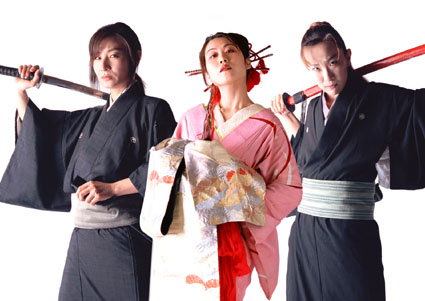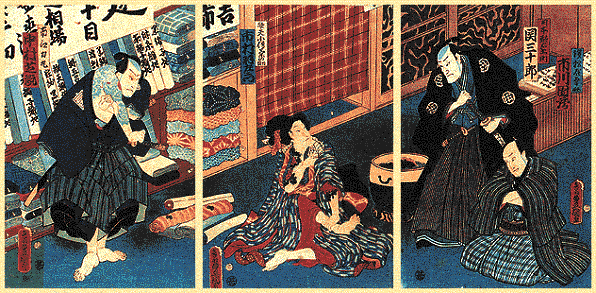
�@
Title: "The Love Crazed Samurai "
Original Work: Namboku Tsuruya
Play: Kiyokazu Yamamoto
Translation: �E�|�u�~�p �B���������y�~�p (Russian),
Esfandyar Dorraj �� Igarashi Hitomi (Persian),
Rei Sudo (English),
Eriko Yamazaki (Chinaese)Director: Show Ryuzanji
Music: Makoto Honda
Action�F�@Takashi Okamoto
Choreography�F�@Mami Kitamura
�@
Cast: Hiroko Ito / Saori Aoki / Nao Kiuchi / Ran Okita / Makoto Honda / Tomomi Yokosuka / Kazuhiro Ueda / Takuhei Kozu / IWAO / Nanaho Unebe / Nanao Kobayashi / Kazuhiko Satomi / Hiromi Yano / Chikara Tomizawa / Kengo Kuramochi / Show Ryuzanji
�@
�@
Language: Japanese �iwith subtitles in English �E Russian �E Persian �E Chinese�j
Length of Show: �@100min
Number of actors: 16 (8M, 8F)
Number of technical staff: �@6 Total : 22
�@
�gTHE LOVE CRAZED SAMURAI�h�@Tour 2005
�@
January 20�`23
China. Beijing�@�k���k���n�i���� (�k����/North Theater)January 28�A29
Iran. Tehran�@ International Fadjr Theatre FestivalFebruary 2�`4
Russia. Moscow�@ Na Strastnom Theatre Center�@�@�S�u�p�����p�|���~���z ���u�~���� �R�S�D �Q�U "�N�p �R�����p�����~���}"February 9�A10
Belarus�@Minsk �N�p���y���~�p�|���~���z �p�{�p�t�u�}�y���u���{�y�z ���u�p���� �y�}�u�~�y �`�~�{�y �K�����p�|��
�@
�@
Outlines
A breathtaking story of men and women, love, hatred, one�fs duty and greed; Ryuzanji Company will present a new version of a Japanese kabuki classic piece in a new kabuki style.
The objectives of our performance
One can say Kabuki is the fountainhead of Japanese stage art. By performing a Kabuki play written 180 years ago at the present time, though with the respects to traditional costumes and stage art, we would like to challenge how human beings today can be lively in the world that were written then. Not by just imitating or arranging the forms of Kabuki, but by bringing fresh words that are spoken now to a Kabuki play, we would like to make a new Ryuzanji�fs Kabuki.
This play is about the fate of men and a woman fooled by money, and about men who deceive and kill each other for Uchiiri, a justified raid for a noble cause.
However, is justice always righteous? Namboku Tsuruya deals with this universal theme and depicts vivid human beings with weakness and greed. Even though this play is written 180 years ago, there is something in common and sends strong messages to today�fs world at the time of war and violence. We would like to revive his world to the present.
About the play
�gThe Love Crazed Samurai�h (original Japanese title is �gKamikakete Sango Taisetsu�h was first staged in 1825, at Edo period in Nakmura Theater in Edo, present Tokyo. The author is Namboku Tsuruya �W, a distinguished playwright whose masterpiece is �gTokaido Yotsuya Kaidan�h. He is noted for his depiction of lives of people who live on the fringe of society. �gKamikakete Sango Taisetsu is not only based on the actual crime, murders of 5 people, and Namiki Gohei�fs play which is the dramatization of the mass-murder, but also related to the most well known Kabuki play �g Chushingura�h.
One of the characteristics of this play is that Namboku depicts the famous Akoh�fs ronin (a samurai who lost one�fs master and now unemployed) Fuwa Kazuemon, the character that appears in �gChushingura�h as a weak and cruel human being with full of greed. Namboku described often hero-worshiped loyal retainer as a vivid human being.
If the characters which Namboku wrote speak today�fs words, they live in today�fs world. By modernizing thoroughly the language of Kabuki, we can reconstruct Kabuki from Edo period into a contemporary play.
This play is about wrongdoers. The picaresque attracts people because the evildoers show the cruelty of this world and desires of human beings, and that is the reality of society which we live in. This play is full of atrocity, which laughs at the didactic stories�f ending where the good always wins in the end, and the world which Namboku draws is dry and vacant. �gKamikakete Sango Taisetsu�h is full of wickedness and eros, and is a very modernistic play.

�@
Theater Reviews on �gTHE LOVE CRAZED SAMURAI�h
By Morio Emori in �gTheater Arts�h Fall, 2004 issue
�gRyuzanji has completely changed the direction of the play this time. Two of the main male characters are played by women: Hiroko Ito as Gengobei Satsuma, and Saori Aoki as Sangoro Sasanoya. The purpose of that is to create a drama that reflects the �gtimes of wars�h today by having �gwomen�h, who pray for peace, �gperform�h the men fighting for meaningless �gtaigi�h (moral law). There�fs singing, dancing, and sword fighting, which should be called �gRyuzanji-Takarazuka-Kabuki�h (Takarazuka is a Japanese theater company only with women.) The direction was successful. Because the two actresses played samurais, the foolishness and sadness of men obsessed with �gtaigi�h have expanded, and the play also reflects today�fs world that �gtaigi�h, which is a supreme ideology, exists. The twists about the money (100 ryo) are very clear, which expresses people getting trapped and ruining themselves for money and love. Nanboku�fs world portrayed with his complicated text, the daily lives of ronins and townspeople with great hardships and their relations with �gtaigi�h, was made to be simple and clear, and Ryuzanji revived the classical piece to the present as a fast pace show full of singing and dancing.�h
Kumamoto Newspaper, August 6, 2004.11.4
�gIt�fs a love-hatred play about a ronin who is deceived by a geisha and her husband, originally written by Nanboku Tsuruya who wrote �gYotsuya Kaidan�h. Mr. Ryuzanji directed it and created an entertaining piece with singing and dancing, which the actors�f energy and the dignity of the play interacted on stage.�h
�@
By Shigeo Kaji in Nikkan Sports, December 10, 2002
�gA show that reconstructed a kabuki piece written 400 years ago as a �gcontemporary play�h and that thoroughly described aesthetics of evil. I was able to see true nature of human beings through the brutal evils.�h
By Osamu Imamura in Asahi Newspaper, December 27, 2002
�gNanboku Tsuruya�fs kabuki piece about a ronin, Kazuemon Fuwa, and cause and effect of money and love became a colorful music play, blooming as a beautiful evil flower on stage.�h
Theater Guide, March 2003
�gIt was the best �gThe Love Crazed Samurai�h I�fve ever seen. The theater was filled with energy. The direction that seems to say what moves the world are lust and greed and the acting were united, which was dragging the audience into Nanboku world. The audience was enjoying it as well.�h
�@
By Tamotsu Watanabe in Theatro, February, 2003 issue
�gThe fast-pace story was easy to understand for anybody and intensified the impact. Watching the play, I realized that Nanboku�fs kabuki surprisingly had a contemporary balance and that the twists about the 100 ryo were rational and debatable at the same time, and I felt like he�fd have a narcissistic smile of satisfaction. The other productions of �gThe Love Crazed Samurai�h should learn the fast-pace and clarity of the play.�h
�@
By Tomoko Saito in Theatro, February, 2003 issue
�gIt was a show that left a heavy impression of the world Nanboku portrayed, of the emptiness of the people involved in bloody Chushingura.�h
�@
By Hiroshi Seto in Manabu, February, 2003 issue
�g�gThe Love Crazed Samurai�h is about people deceiving and killing each other for a raid and �gtaigi�h.
The fierce sword fighting scenes are the highlights in kabuki, but the Ryuzanji version more focused on the relationships between the characters than the action scenes. They�fre the people who struggle between their mission to make a raid and personal feelings. Is it allowed to deceive and kill someone for �gtaigi�h? How many victims are there behind it?
I�fve seen different productions of �gThe Love Crazed Samurai�h, both kabuki and contemporary versions, but this one made me really understand the structure of the play.�h
�@
�@